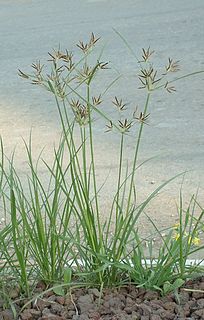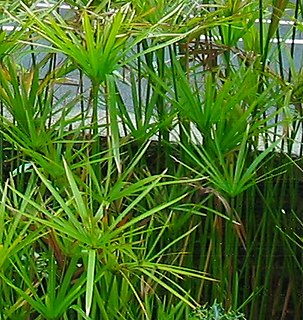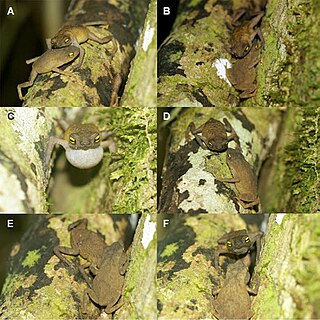
Cyperus papyrus, papyrus, papyrus sedge, paper reed, Indian matting plant or Nile grass, is a species of aquatic flowering plant belonging to the sedge family Cyperaceae. It is a tender herbaceous perennial, native to Africa, and forms tall stands of reed-like swamp vegetation in shallow water.

The Cyperaceae are a family of graminoid (grass-like), monocotyledonous flowering plants known as sedges. The family is large, with some 5,500 known species described in about 90 genera, the largest being the "true sedges" genus Carex with over 2,000 species.

Cyperus is a large genus of about 700 species of sedges, distributed throughout all continents in both tropical and temperate regions.

Cyperus rotundus is a species of sedge (Cyperaceae) native to Africa, southern and central Europe, and southern Asia. The word cyperus derives from the Greek κύπερος, kyperos, and rotundus is from Latin, meaning "round". The earliest attested form of the word cyperus is the Mycenaean Greek 𐀓𐀞𐀫, ku-pa-ro, written in Linear B syllabic script.

Cyperus alternifolius, the umbrella papyrus, umbrella sedge or umbrella palm, is a grass-like plant in the very large genus Cyperus of the sedge family Cyperaceae. The plant is native to West Africa, Madagascar and the Arabian Peninsula, but widely distributed throughout the world. It has gained the Royal Horticultural Society's Award of Garden Merit. The subspecies Cyperus alternifolius ssp. flabelliformis is also known as Cyperus involucratusRottb..

The solitary tinamou is a species of paleognath ground bird. This species is native to Atlantic forest of eastern Brazil.

Frostius pernambucensis, or the Frost's toad, is a species of toad in the family Bufonidae. It is endemic to the eastern Brazil where it is known from the Paraíba, Pernambuco, Alagoas, and eastern Bahia states.

Cyperus eragrostis is a species of sedge known by several common names, including tall flatsedge, nutgrass, tall nutgrass, umbrella sedge, chufa, Earth almond, zula nuts, edible galingale and pale galingale.

Cyperus fuscus is a species of sedge known by the common name brown galingale, or brown flatsedge. This plant is native to much of Europe, Asia and North Africa from England, Portugal and Morocco east to China and Thailand. It is an introduced species in North America, where it is naturalized in widely scattered locations in the United States and Canada.
Cyperus scariosus is a perennial herbaceous plant from Australia and New Guinea.

Cyperus laevigatus is a species of sedge known by the common name smooth flatsedge.

Bulrush is a vernacular name for several large wetland grass-like plants

Cyperus javanicus, also known as the Javanese flatsedge, is a sedge of the family Cyperaceae that is native to Indonesia and Australia.
Acianthera pernambucensis is a species of orchid plant native to Brazil.
Inaechelys is an extinct genus of bothremydid pleurodiran turtle that was discovered in the Maria Farinha Formation of Brazil. The genus consists solely of type species I. pernambucensis.
Cyperus pilosus is a species of sedge that is native to parts of Asia and Australia.
Cyperus reflexus is a species of sedge that is native to parts of the Americas.

Cyperus aggregatus is a species of sedge that is native to the Americas.












